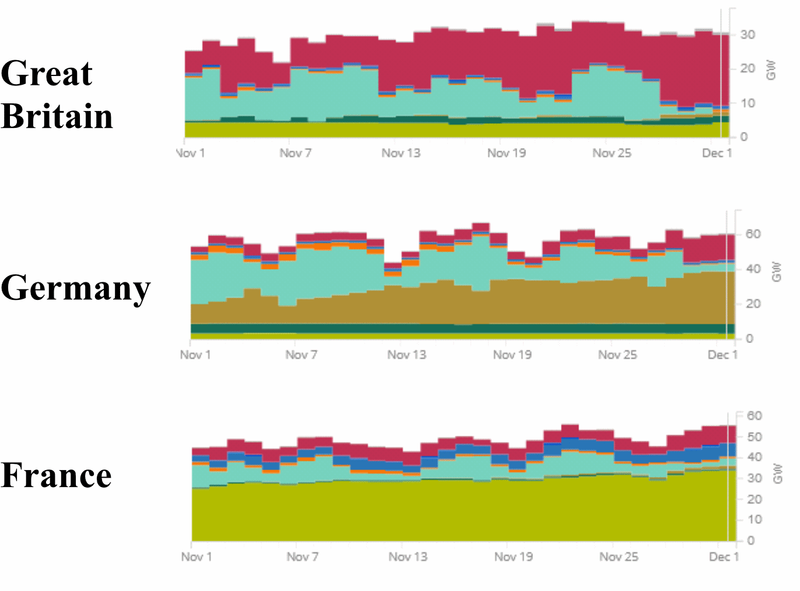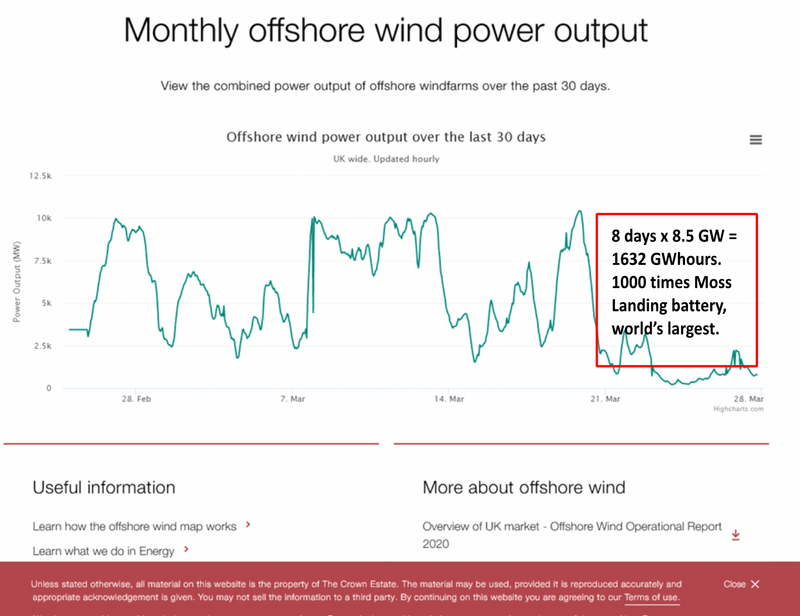This month
- Happy Christmas 2022
- Sizewell C
- On nuclear power in Scotland
- Electricity price fluctuations
- The production of electricity as the wind speed changes
- Hydro
- Low Dose Radiation and Hormesis
- This month’s featured article: Hydrogen
Happy Christmas 2022
This month brings the 80th anniversary of the world’s first man-made nuclear reactor, on December 2 to be exact. Here are two Christmas Quiz questions with which to surprise your friends and relatives at an appropriate point.
- How long did it take to build this reactor? Two years? Two months? Two weeks? Or, since it was the “First of ANY Kind” of reactor, perhaps it took 20 years? [Answer: 2 weeks, I read]
- And then was this the first known nuclear fission reactor? [Answer: Google the story of the Oklo Reactor in Gabon]
Here is some more fun to mark the occasion https://www.linkedin.com/posts/argonne-national-laboratory_chicago-pile-1-a-brick-history-activity-7004432977266896897-vxaN
Sizewell C
Government approval comes slowly but surely. Ownership will be shared with EDF 50:50, EDF now being wholly owned by the French Government. The Government has put £700 million on the table which includes the cost of buying out the Chinese interest. Further funds are expected from the private sector. This will still leave a Chinese participation at Hinckley Point C, I believe.
On nuclear power in Scotland
Adrian Bull MBE writes
The issue in Scotland isn’t energy policy, per se, but planning. Energy policy is not a devolved matter (so – in theory – the BEIS team in Whitehall decide on energy policy for the whole of the UK). However, planning policy (for anything above 50MW) is devolved to the Scottish Parliament (see here https://www.gov.scot/policies/energy-infrastructure/energy-consents/
That means whatever Westminster might wish to see built – the Scots can block it, if it’s over 50MW. Whilst the SNP remain so anti-nuclear, nobody is going to wish to invest in nuclear plans North of the border. Even if SNP were to lose power, the prospect of them regaining it and reversing any prior planning approval during construction would be an impossible barrier to investment.
Electricity price fluctuations
At the risk of repeating points already made elsewhere, consider what happened in UK on 29 Nov at 5pm, as posted by ElectricityMap (https://app.electricitymaps.com/zone/GB). The spot price for electricity rose to 1398.43 euro per MWh – domestically that would be 1.398 euro per unit. Fortunately, or rather unfortunately, domestic consumers do not pay that much and the stabilising effect of their response to this price spike is suppressed. Nevertheless, this is the cost set by the marginal supplier persuaded to contribute to meet current demand. According to the market rules, all suppliers are then paid at this rate. All utilities have to pay and attempt to pass the cost on to their customers, with or without government help. As a result, the suppliers make excessive profits and the utility companies are liable to collapse. The domestic customer demand remains unresponsive. Industrial customers may be forced out of business if their needs are inflexible, as many are. So is dynamic domestic charging required if supply is to use more intermittent renewables?
I appreciate that this is not the whole story because some supplies are bought on forward contracts. This may describe the underlying market, but I have more reading to do here: http://www.dieterhelm.co.uk/.
What was the balance of supply and demand on 29th Nov 2022 at 5 pm? Demand was 40.8 GW – and so supply had to be the same. Nuclear provided 3.96 GW, gas 22 GW, biomass 2.05 GW, hydro 1.1 GW, hydro-storage 1.58 GW, coal 0.994 GW, wind 0.957 GW, and solar nil as the sun had set. That totals 32.6 GW. Imports totalled 6.4 GW made up of: 1.05 GW from Belgium, 2.50 GW from France, 0.406 GW from Ireland, 1.04 GW from Netherlands and 1.40GW from Norway – there were no exports. [The small mismatch is presumed due to N Ireland, rounding etc.] This import was costing GB 6400 × 1398 = 9 million euro per hour. This may be exceptional, but the flow seldom goes the other way. What is wrong?

This plot, taken from ElectricityMap, shows the sources of electricity generation in Great Britain Germany and France for the month of November 2022. Red is gas, blue-green is wind, brown is coal, dark green is biomass, olive green is nuclear, dark blue is hydro, orange is solar. The differences between the three countries are essentially political, not environmental. Solar makes no great contribution to grid electricity in any case. All three countries have large relatively synchronous fluctuations in wind with a dearth at the end of the month in every case. The vertical axis shows that GB uses much less electrical power, largely because it relies on gas for heating. This accentuates the heavy dependence on gas, already dominant for electricity generation. Germany relies heavily on coal, evidently, increasing during the month as the wind failed. Modest contributions are made by biofuels and France makes steady use of hydro. However, the major difference is nuclear. Whereas this adds usefully in Great Britain, in France it is larger than the entire GB electricity production. French nuclear ramped up slightly during the month for the extra seasonal demand. France had no difficulty in accommodating the loss of wind on the 29th. Germany just burnt more coal. The loser was Great Britain.
One government policy after another has made the situation worse. The rundown of our nuclear industry, the sale of the rest of it to EDF, the closure of most coal-fired stations and the “dash for gas”, and then, most recently, the policy of investing in Renewables, offshore wind in particular. Why has this been so ill-judged? Because it seems that the Government has no idea of the elementary physics of wind power
The production of electricity as the wind speed changes
The kinetic energy carried by a Kg of wind with velocity v is ½ v2. The mass of wind hitting one m2 of area swept by a turbine in a second is ρ × v, (ρ being the density of air). So the maximum power per m2 of swept area is ½ ρ v3, assuming 100% efficiency – and no technology can improve on that.

The values of the density of air and a moderate wind velocity indicate an uninspiring power of about 600 watts per m2, about the same as solar. That is why both wind turbines and solar arrays are so huge. But there is an extra problem for wind. Since the power goes as v3, when the wind drops be a factor 1/2, as happens frequently, the power drops by a factor 1/8. Furthermore, when the wind speed doubles, the power increases by a factor 8 and the turbine has to be turned off to prevent damage. This physical factor has a large amplifying effect on wind fluctuations beyond the reach of any technical design improvement. This effect is not obvious to a casual observer – or to an investor concerned with financial factors.
The plot of electricity production by UK offshore wind in March 2022 shows that, while it ran close to 10 GW on some days, on others it fell far short for extended periods. At the end of the month in particular, it fell short by 8.5 GW for 8 days. The missing energy, 1632 GWhours, would require 1000 batteries, as big as the largest ever made. Bearing in mind that, even now, the total electrical power required is near 40 GW, not 10 GW, and, if fossil fuels are to be discontinued by 2050, the wind network and batteries would need to be much larger (unless replaced by nuclear instead). Furthermore, by then at least twice as much power will be needed, especially if the switch to electric cars is maintained. Then also, mineral deposits needed for batteries, wind turbine magnets and solar arrays are already in short supply and in politically awkward places. In summary, the suggestion that the “renewable” conjuror can produce an order of magnitude more rabbits out of his sleeve, just because the voracious socio-economic machine insists he should, is not tenable.
Hydro
Compared to other renewables hydro seems a rather reliable source of energy. It is not intermittent and offers the only high capacity storage solution with a fair round-trip efficiency. Safety figures are poor because dam collapse often has a high death toll. A new problem is its vulnerability to changing weather patterns., Because of reduced flow in the Colorado River in the US, Lake Mead is only 27.7% full, down 22 ft in a year, and Lake Powell is only 23.5% full, down 13.3 ft in a year. In Africa the water level at the Kariba Dam has dropped to 4.1 percent of usable storage threatening power supplies to both Zambia and Zimbabwe. Evidently, reliance on hydro in a changing climate carries significant risks.
Low Dose Radiation and Hormesis
Low doses of radiation at low rates are harmless, even beneficial. This is quite surprising to most people, especially as this is still denied by the medical profession, despite its informal therapeutic role in many spas since Roman times. It is helpful to read about its history, and the wide variety of people who have studied it carefully and written about it over the years. Here is a useful compilation of sources and authorities on the subject that can be recommended: https://www.radiation-hormesis.com/.
The need to replace the radiation regulations is widely acknowledged: https://thegermanyeye.com/radiation-fraud-must-be-exposed-3711. Unfortunately those with a responsibility to uphold these regulations feel unable to initiate the required change. One such senior voice messaged me in reply to a posting,
Thank you for this. Within the nuclear industry, we live this stuff and constantly battle with these misconceptions. We do what we can to counter the arguments but there’s a world of difference between us “with a vested interest” saying these facts and an Oxford professor taking the time and effort to put something out. So thank you.
Evidently, we need to keep up the pressure in the New Year – eventually the truth will out!
This month’s featured article: Hydrogen
This month’s featured article by SONE member, Paul Spare, is a carefully considered account of the prospects for Hydrogen as a major component of the UK energy supply. It is well worth reading:
Link: https://sone.org.uk/hydrogen-storage-how-much-will-it-help/
Wade Allison5 December 2022
